
Photo by Dona
Douglas dropped us at our rental car place in Arusha, which was not easy to find. Our car was brought to us shortly, but some of the things we had pre-arranged to rent with it were not. We had asked for a two person tent, a small stove with fuel, extra water and fuel jugs, foam sleeping pads, and a cookset. The cookset had been forgotten, as had the foam pads. The auxilliary fuel jug was a duplicate of the auxilliary water jug, a cheap imported plastic jug totally unsuitable for fuel. The rental car folks went out and bought a pot in a market someplace, then retrieved the foam pads from someplace. I think the foam pads had been purchased also, but maybe not; they certainly looked brand new; we later saw lots of them for sale cheaply in Moshi town. They were bulky as heck, but also pretty comfortable. I could compact them pretty well, but I'm kind of obsessive in regards to stuff sacks and other means of fitting things into small spaces. The pot was way larger than we wanted, and without a lid; but it would work, and we needed to be off. It wasn't a big deal, but didn't give us a lot of confidence.
The car was a Toyota Rav 4, what we had arranged. It was quoted as $100/day, but we had a mix-up and were charged $1000 for nine days. The claim was something like "If you get the car on the 4th and bring it back on the 5th, that counts as two days." When I indicated that rentals are normally charged per 24 hour period, not per calendar day, the claim changed to something like "You were driving long distances. Driving out of town is different and hard on vehicles, so if you rent today and bring it back tomorrow that is two days." I didn't bother asking what about the days when it wasn't driven at all; do we get a discount for that? I'm sure the answer would have been that they couldn't rent the car during those days, which would be right; but it does negate the wear on the vehicle angle. Anyway, that part was not fun, and left a bad taste in our mouths; we ended up paying the extra. It was the one negative experience we had while in Tanzania. The rental agency was "Seasons Tanzania Safaris and Tours", seasonstanzaniasafaris.com, and I would not recommend them.
The car was smaller than we expected, but we had no gripe there. All of the RAV4s we've seen in the U.S. were four-door models; we didn't even know they made a smaller two-door model. But that's what we got. It was a little cramped but worked out ok.
After loading up, they pointed out that the vehicle needed gas right away. That was an understatement -- they had siphoned the tank pretty dang close to dry. They told us where the nearest fuel station was, a block away; we made it ok, but when we went to open the fuel-cover door, we couldn't locate the button / lever / magic trick. So we looked in the glove box for an owner's manual, and found one -- in Japanese. We were backing up traffic at the fuel station, and no-one seemed able to locate the fuel door lever. After some time the rental guy showed up, having remembered there was a problem with that, and showed us the lever for the fuel door to the right of the passenger seat on the floor. And the fact that you had to leave the key in the ignition (maybe...) to make it work. So with that now explained we fueled up, filled up our auxilliary 20 liter fuel jug, and headed out. The fuel jug sloshed and dripped for the next ten days, but fortunately we didn't have any rear-end collisions.
Once we got out of town and could relax a bit, we checked out more of the instrument panel and found two buttons labelled in Japanese only. I think one was some sort of overdrive, but I'm not sure; I haven't a clue what the other was; it never seemed to do anything -- not even an emergency seat ejection.
Our destination for the night was Lake Chala Safari Camp, northeast of Moshi. They allow tent camping and what we wanted was a simple place to spend the night. We had instructions on how to get there, and they mostly worked. In the vicinity of Hemo Junction they were screwed up and confusing, and it was at that point, that we began to understand something that was eating its way into our consciousness: Roads are not marked in Tanzania. None of them. Big, small, main route, off-the-beaten-path; it doesn't matter. What you really need is accurate local instructions like "go left at Hemo Junction." Our local instructions were not the best, but we made it with only a couple of backtracks. The directions on the Lake Chala Safari Camp website have since improved.
The road was mostly good, although a bit washed out in places. But after all the other roads we had already been on it looked like a highway.
 |
| Lake Chala Road
Photo by Dona |
The camp at Lake Chala was delightful, and just what we needed. Our tent, however, was a disappointment. It was a cheap Asian imitation of a modern tent. They did give us a piece of black plastic to use as a "footprint" underneath the tent itself. As for the tent proper, there was a square cutout in the top where the semi-waterrepellent tent material was replaced with mosquito netting. That seems like a reasonable idea when the weather is nice. But it had no rainfly, only a small piece of fabric the same as the tent material which was barely larger than the cut-out, and you were supposed to tie it over the hole at the top. The mosquito netting for the entrance to the tent had holes in it, and the zipper was torn lose and left another hole. Fortunately, we had brought our own mosquito net in case we needed it somewhere else, but in this case we draped it over the whole tent.
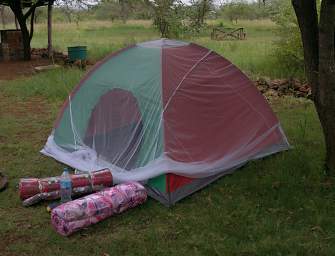 |
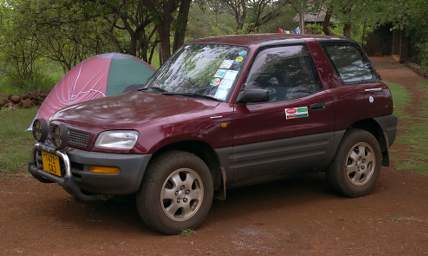 |
| Tent | Toyota Rav4 |
This campspot, and some others, advertised hot showers. It took us a while to realize that meant someone stoked a fire someplace to heat the water up. Unfortunately, we didn't realize they did this on the assumption that everyone will always want hot water. We didn't feel in need of a hot shower, so that effort, energy, and pollution probably could have been saved.
 |
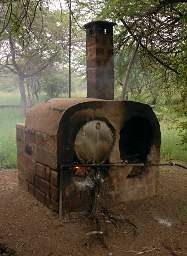 |
| Lake Chala Camp Spot
Photo by Dona |
Water Heater |
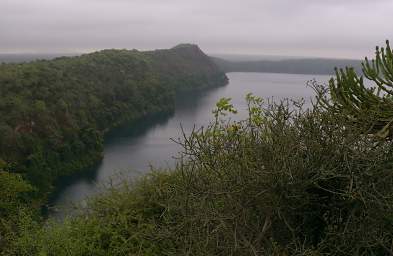 |
| Lake Chala |
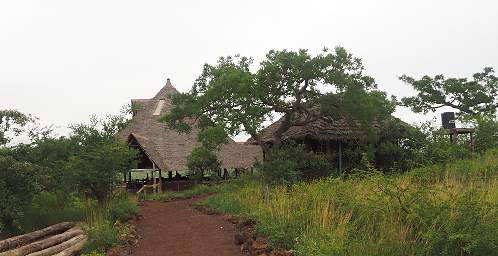 |
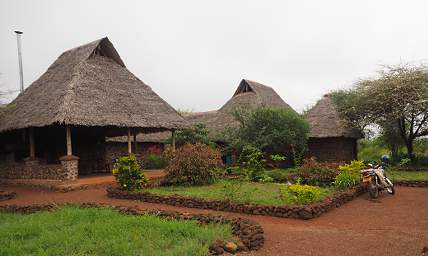 |
| Lake Chala Camp | |
We had a long drive the next day, so we didn't hang around to enjoy the area. We did notice nice birds in the morning. I don't know if they had a way to get down to the lake or not, or whether they had boats you could rent or not.
On our way out we took a wrong turn, so we just wandered around the back roads and followed our noses from one village to the next, heading in the general direction we needed (south) until we hit the main highway. We were aware that we were near the Kenya border, and wondered what would happen if we ended up in Kenya. It was not clear whether any of these roads crossed into Kenya or not. As it turned out, we came out at Hollili, right at the border.
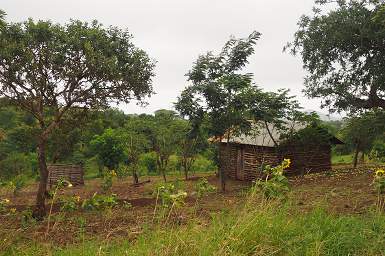 |
| House |
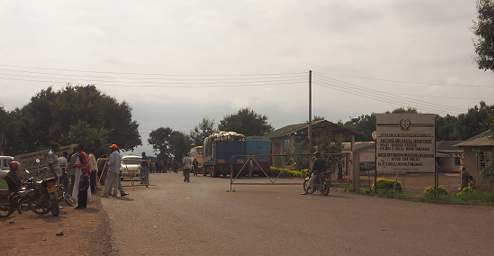 |
| Kenya Border |
Then we were on main roads, and we headed southeast towards the Amani Nature Reserve. We decided we needed a cheap plastic tarp so we could rig some kind of a rain shelter over the tent, so we stopped several places and I tried with my limited (very limited) Swahili to convey what we was looking for. We had a small book on teaching yourself Swahili, "Simplified Swahili" by Peter M. Wilson. It is actually pretty good, but we hadn't made it too far through it. I have to go back and repeat things about ten times before I remember much, at least as far as language type stuff is concerned, so it was slow going. It had a small dictionary in the back and we had enough grammar to put together "blue tarp". I have written in my diary "Ninataka chandalua kibluu qua mvua." That was supposed to mean "I want a blue tarp for rain." It must not have been too accurate, because the first two places we went everyone said "ndiyo" (yes) and tentatively showed me a white mosquito netting. But eventually I found a shop where the clerk said "ndiyo" in a positive way and pointed to a regular old cheapo made-in-china blue plastic tarp -- exactly what we were looking for. Except it was about four sizes too big. But it was all he had, and not too expensive, and we were really worried about rain, so we bought it. That was a good idea.
We followed the main Arusha to Tanga and Dar es Salam highway down the south side of the Pare and Usambara mountains. The foothills where we were traveling were populated with farms, many of them raising sisal. Tanzania used to be one of the world's biggest suppliers of sisal, which used to be used a lot for various forms of cordage (rope, string, etc). But that use has been mostly supplanted by synthetic products of nylon and dacron, and the industry has pretty much collapsed.
Sisal plants themselves are pretty cool. They are a member of the same family as the Yucca and Agave, and look the part, only they got the "giant" gene. The leaves are the part used to make cordage, as they can be separated into long fibers which are relatively strong and can be woven together.
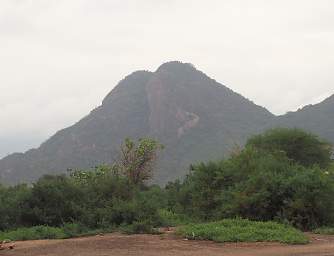 |
| The Northeast Mountains |
 |
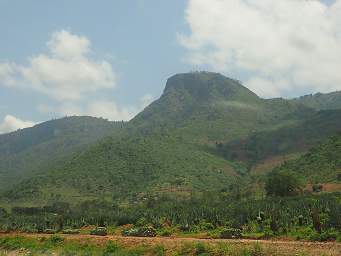 |
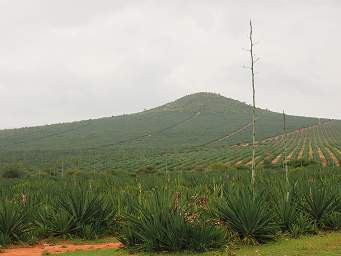 |
| Sisal |
Douglas had warned us to not speed, and I normally don't drive too fast anyway. But things in Tanzania are not well marked. In a lot of places they aren't marked at all. That is probably deliberate. We were traveling on some nice new road and eventually, as we passed a wide spot in the road with a few houses on both sides a fellow in a uniform flagged us over. He informed me I was speeding, and showed me his radar gun and it said I was doing 60 km/hr, about 10 km/hr over the limit. I told him I thought the speed limit was something higher, and that the 50 km/hr limit was for towns. "We are in a town." I asked if there was a speed limit sign when we entered the town. "No." There wasn't even a sign for entering the town. How I was supposed to know we were in a town? "Because there was a house by the road." He clearly had all day and we wanted to get to Amani before dark, so we paid up. He asked if I wanted a receipt, and I said yes, thinking somehow that would mean the money went where it was supposed to go. A few days later someone told us an audit of the traffic tickets showed something like $20,000 total collected for the whole year for all of Tanzania. So a lot of the money collected clearly is not going where it should. Our informant also mentioned that once they got stopped and accused of speeding, and asked the officer to point the radar gun at a post. It registered 30 km/hr. I asked the officer if I could take his picture, and he was happy to oblige. I was speeding, but I felt a bit taken advantage of because there wasn't a sign for either the speed limit or the supposed town. But mostly I was mad at myself.
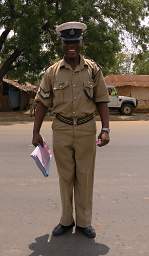 |
| Traffic Cop |
Eventually we got as far southeast as we were going to go and turned back into the mountains. We found the turn off for Amani and the road turned to dirt. A red clay dirt that would be slippery as heck when wet. Then it got narrower. Then it got steeper. Eventually we came to a gate and paid an entrance fee, and got a sample of some Jackfruit, "Fenesi". It wasn't too bad.
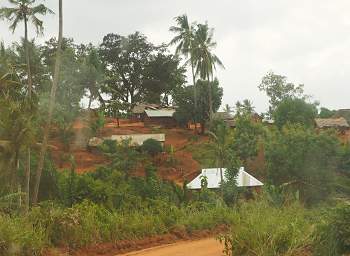 |
| Rural Houses
Photo by Dona |
We continued on. Luckily, every time we came to a fork in the dirt path there would be a sign that said "Amani Camp" and an arrow pointing that-a-way. It had obviously been raining recently, and the road was very narrow and rutted. I put the car into 4WD and was glad we had it. The last bit was narrow, steep, and rutted. Then we got to the top, and there were three buses parked there. There's no way I would have tried to drive one of those buses up there. Our camp spot was filled with kids from the international school at Dar es Salam on a holiday. The camp host found us a spot a ways away from the kids and we pitched our tent, with our new fly over it. It was drizzling slightly. Then we found a table under the roof where we could relax, eat something, reflect on the day, talk to the kids and their chaperones, and play some bananagrams.
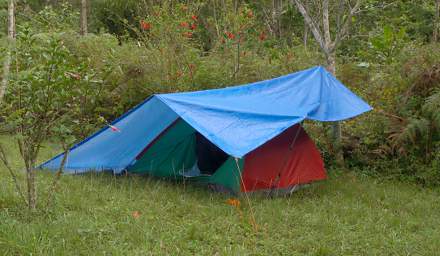 |
| Amani Tent |
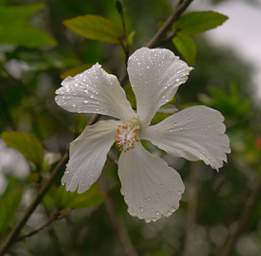 |
| Xxx White |
We got a good night's rest, then spent the next couple of days exploring the Amani Nature Reserve.